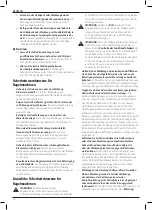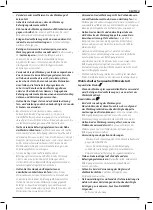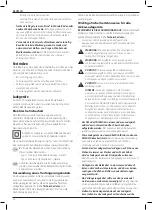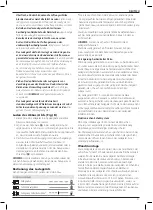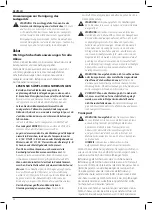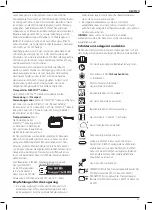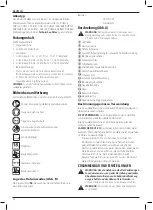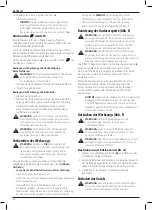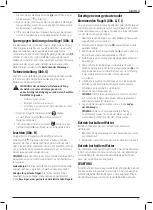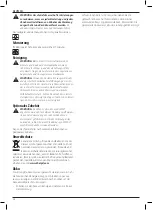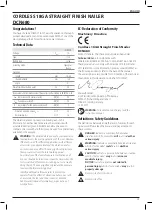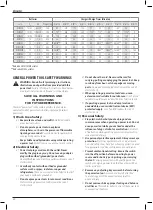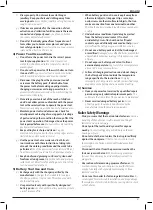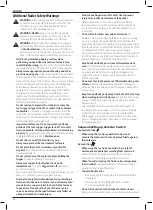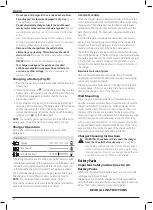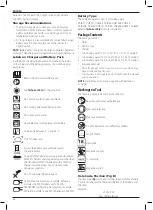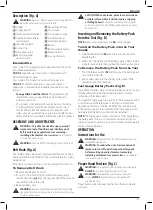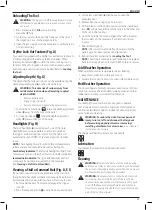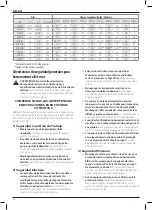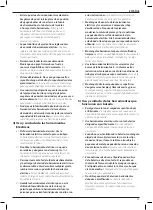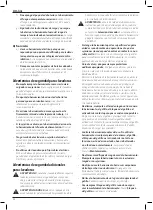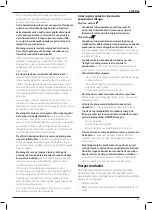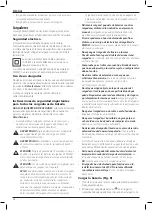
32
EngLIsh
Additional Nailer Safety Warnings
WARNING:
When using any nailer, all safety precautions,
as outlined below, should be followed to avoid the risk
of death or serious injury. Read and understand all
instructions before operating the tool.
WARNING: NEVER
spray or in any other way apply
lubricants or cleaning solvents inside the tool. This can
seriously affect the life and performance of the tool.
WARNING:
if the tool has been dropped or you suspect
tool damage perform tool operation check as defined in
the
Mode selection
section of the manual. If it doesn’t
perform according to the manual, stop using the tool and
have it serviced at an authorised
D
e
WALT
service centre.
•
Hold tool by insulated gripping surfaces when
performing an operation where driven fastners may
contact hidden wiring.
Contact with a “live” wire will make
exposed metal parts of the tool “live” and shock the operator.
•
Always wear appropriate personal hearing and other
protection during use.
Under some conditions and duration
of use, noise from this product may contribute to hearing loss.
• Disconnect battery pack from the tool when not in use. Always
remove battery pack and remove fasteners from magazine
before leaving the area or passing the tool to another
operator. Do not carry tool to another work area in which
changing location involves the use of scaffoldings, stairs,
ladders, and the like, with battery pack connected. Do not
make adjustments, perform maintenance or clear jammed
fasteners while battery is in place.
•
Do not remove, tamper with, or otherwise cause the
tool, trigger, trigger lock-off, or contact trip to become
inoperable.
Do not tape or tie trigger or contact trip in the
on position. Do not remove spring from contact trip. Make
daily inspections for free movement of trigger and contact trip.
Uncontrolled discharge could result.
•
Inspect tool before use. Do not operate a tool if any
portion of the tool, trigger, trigger lock-off, or contact
trip is inoperable, disconnected, altered, or not working
properly.
Damaged parts or missing parts should be repaired
or replaced before use. Refer to
Maintenance
.
•
Do not alter or modify the tool in any way.
•
Always assume that the tool contains fasteners.
•
Do not point the tool at co-workers or yourself at
any time.
No horseplay! Work safe! Respect the tool as a
working implement.
•
Do not carry the tool from place to place holding the
trigger.
Accidental discharge could result.
•
Always use trigger lock-off when tool is not in
immediate use.
Using the
trigger lock-off
will prevent
accidental discharge.
• Do not overreach. Maintain proper footing and balance at all
times. Loss of balance may cause personal injury.
•
Use the tool only for its intended use. Do not discharge
fasteners into open air, concrete, stone, extremely hard
woods, knots or any material too hard for the fastener
to penetrate. Do not use the body of the tool or top
cap as a hammer. Discharged fasteners may follow an
unexpected path and cause injury.
•
Always keep fingers clear of contact trip to prevent
injury from inadvertent release of the pusher.
• Always operate the tool in a clean, lighted area. Be sure
the work surface is clear of any debris and be careful not to
lose footing when working in elevated environments such
as rooftops.
•
Do not drive fasteners near edge of material.
The
workpiece may split causing the fastener to ricochet, injuring
you or a co-worker. Be aware that the nail may follow the
grain of the wood (shiner), causing it to protrude unexpectedly
from the side of the work material. Drive the chisel point of the
nail perpendicular to the grain to reduce risk of injury.
• Do not drive nails onto the heads of other fasteners or with the
tool at too steep an angle. Personal injury from strong recoil,
jammed fasteners, or ricocheted nails may result.
•
Keep hands and body parts clear of immediate work
area.
Hold workpiece with clamps when necessary to keep
hands and body out of potential harm. Be sure the workpiece
is properly secured before pressing the nailer against the
material. The contact trip may cause the work material to
shift unexpectedly.
•
Do not use tool in the presence of flammable dust, gases
or fumes.
The tool may produce a spark that could ignite
gases causing a fire. Driving a nail into another nail may also
cause a spark.
•
Keep face and body parts away from back of the tool cap
when working in restricted areas.
Sudden recoil can result
in impact to the body, especially when nailing into hard or
dense material.
• Grip tool firmly to maintain control while allowing tool to
recoil away from work surface as fastener is driven. In Bump
mode if contact trip is allowed to recontact work surface
before trigger is released an unwanted fastener will be driven.
• Choice of triggering method is important. Check the manual
for triggering options.
Sequential/Bump Selector Switch
Sequential Action
•
When using the tool in sequential mode, do not
actuate the tool unless the tool is placed firmly against
the workpiece.
Bump Action
•
When using the tool in bump action, be careful of
unin tentional double fires resulting from tool recoil.
Unwanted fasteners may be driven if the contact trip is
allowed to accidentally re-contact the work surface.
•
When “bump” actuating the finish nailer, always keep
tool in control.
Inaccurate placement of tool can result in
misdirected discharge of a fastener.
•
To Avoid Double Fires:
-
Do not engage the tool against the work surface with a
strong force.
-
Allow the tool to recoil fully after each actuation.
-
Use tool in sequential mode.
•
Do not drive nails onto the heads of other fasteners.
Strong recoil, jammed fasteners, or ricocheted nails may result.

